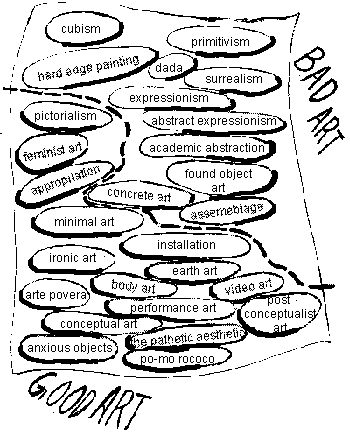|
PROBLEMS
IN ART APPRECIATION FOR THOSE WHO ALREADY APPRECIATE ART By Marcus Adams |
||||||||||||||
| If you don't squeeze nothing comes out... | ||||||||||||||
 |
||||||||||||||
|
I
N T R O D U C T I O N |
||||||||||||||
INTRODUCTION |
||||||||||||||
| The following are allegories or mental models for ways people conceive of and evaluate works of art. The reason these are problems is there is a decided human tendency to make distinctions and categories and then assume that they are reflective of a true reality. After the categories are organized and prioritized, judgments can be made. The forming of categories is of course essential to thinking and maintaining sanity. However, it is the utmost folly to assume that the categories you have created, inherited or accepted are necessarily true or essential. If post-structuralism and postmodernism have taught us anything it is the relativity of our concepts, constructs and categories. I originally developed these ideas as I saw people using them to evaluate and validate works of art. Very often the person supported their evaluations with something that can be approximated by the following models. More often than not they were largely unconscious of the categories they employed. | The most ironic form of this type of evaluation are those people who are superficially committed to postmodern forms and prize work done in this way above all others, but fail to grasp the larger lesson of the postmodern condition which is a self critical awareness of any category or construct. Finally I would like to mention that I have discussed these ideas with people who clearly employ some of the models listed below, but when I mentioned the model being used, without demonstrating their particular use of it, they responded that only the most superficial appreciator would make evaluations in such a way. We all make and utilize categories constantly to order our existence; however, remaining conscious of this activity and allowing each new experience to influence your categories as opposed to letting your categories dictate your experience is not only the basis of the scientific model but essential to appreciating new forms and experiences that cross or confound existing categories. | |||||||||||||
|
Purse Building Home Critique Cleft Palette Cleft Palette Metropolis-June'98 Appreciation-August'98 Young/Old Mushroom Front of the Flock Bandwagons Conclusion
Email
Credits |
||||||||||||||
 |
||||||||||||||
P
|
||||||||||||||
THE PIGEON HOLE GAME |
||||||||||||||
| The pigeon hole game is played, largely unconsciously, by people in all walks of life. It can be played regarding anything with which one is concerned. However, I will focus my attention on how it is used in appreciating art. To play this game you create a pigeon hole for every type, kind, style, of art of which you are aware. Then you arrange all of your pigeon holes in one place. Next draw a line through that place so all the "good" holes are on one side and all the "bad" holes are on the other. This line need not be straight. Now you are ready to play. Go look at some art you have not seen before. Be sure to give it at least a moment's consideration. Then place it in the most appropriate hole. Now you are ready to pronounce a judgment as to its quality. Is it on the "good" side of the line or the "bad" side of the line? You can undoutably see the advantage of this game. *see illustration No more of that tiresome confusion when looking at new works of art. No more of that gnawing insecurity about what people might think about what you think about a new work. Obviously "good" things have "good" things in common and "bad" things have "bad" things in common. One of the problems to watch out for is things that do not fit any of your holes. | This should of course be taken as an affront. You did not go through all this trouble for nothing, and your schema is obviously based on the true nature of things. A couple of solutions to this problem are: A) it is not art because it does not fit on the map of what art is, i.e., your collection of pigeon holes, B) make a pigeon hole at the bottom of your collection for things labeled "other". Depending on your prejudices you can put it on either the "good" or "bad" side of the line, or even past the reach of the line if you are comfortable with suspending judgment. The above may sound absurd, but you would be surprised how prevalent it is. Think how difficult the alternative is: to evaluate each new experience without handy categories that have already been determined as good and bad. This is asking people to consciously consider how and why they made judgments and how those judgments integrate with their previous judgments and experience. To ask people to break their pigeon holes open into larger more amorphous overlapping fields that are continually and consciously being modified as each new experience effects all previous judgments is perhaps asking to much. | |||||||||||||
YOUNG/OLD MUSHROOM |
||||||||||||||